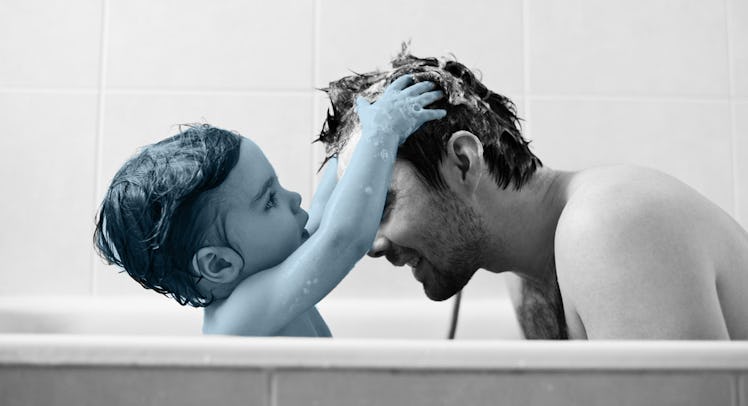How to Take a Bath or Shower With Children and Not Make It Weird
It's a great way to teach kids to be comfortable in the bathroom and comfortable with themselves.

Parents join their children in the shower to bathe all around the world. Not only is there nothing wrong with that, but a shared bath or open shower is also often a necessity for a parent struggling to get free time or caregiving alone. Done right, the family shower can provide an effective forum for a child to wash independently and learn a bit about body anatomy while becoming comfortable with their own body. That’s all for the better right up until it’s not. When that happens depends largely on how parents feel about nudity and what message they want to send.
When Is it Weird to Have Your Children in the Shower With You?
“The general rule of thumb is by the time children reach school age, around five years old, they shouldn’t be showering with you,” says Dr. Richard Beyer, a licensed psychologist in Arcadia, California. “That’s the conventional wisdom, the general cutoff line.”
Beyer is quick to add that the bathroom can become a classroom of sorts, one where parents can teach the kids about basic hygiene habits through hands-on interaction, demonstration, and mimicry. It’s where kids see how to use the toilet properly and discover how their bodies work in general. He further adds that parents should feel comfortable in front of their children, although compared to our European counterparts, we’re a decidedly prudish bunch. While no family needs to go full nudist colony, making kids feel comfortable with their naked bodies is a great way to fuel confidence, self-esteem, overall openness later in life.
While the “conventional” wisdom is that age five is the general time a child should be experiencing autonomy in the bathroom, it’s more than likely that the child will indicate that they’re ready to be alone without prompting. It could be as simple as a little girl telling her parents she wants to take a bath alone, or suddenly showing reservations about nudity and avoiding it. Some kids, though, tend to treat being naked in front of others with the lax attitude of a hedonist at a nude beach. When that’s the case, Beyer recommends gradually getting children used to showering, bathing, and using the toilet alone by implementing encouraging verbal cues before they enter schools.
How to Shower With Your Kid and Not Make it Weird
- When parents join their children in the shower, they are presented an opportunity to model comfort in their bodies for their kids, teaching them to be okay with themselves and their imperfections.
- Parents may want to stop showering with kids around the age of five when it becomes likely kids can be independent and when it also becomes likely that the behavior will be misinterpreted.
- Even once parents stop showering with kids, because they or the kids became uncomfortable, they should be careful not to stigmatize nudity. Nudity happens. It’s best that kids not see it as a big deal.
“Three to six months before they enter kindergarten, start transitioning. ‘You’re a big girl. Now it’s time to teach you how to do this on your own,’” says Beymer. “A lot of it is in the teaching, in the setup. It’s how you approach it.”
Working Toward Kids Shower Independence
Parents want children to feel confident and normal in their bodies and demonstrating that confidence is a key to instilling that value. The bathroom is the most logical place to do that (the only acceptable place if one lives with the in-laws). Still, even bathroom nudity is uncomfortable for many, many parents, and a lot of that discomfort is rooted in values and mores passed down over generations. When it comes to bathroom time, a parent who treats nudity as a natural part of the day is likely to raise a child with a similar attitude, while a parent who spends shower time hiding their body at all costs is going to likely raise a child who views nudity as shameful or wrong, even if dad tells the child that everything is normal.
“Kids get taught two ways: verbally and nonverbally. Your nonverbal actions are stronger than verbal actions,” says Beyer, stressing that parents shouldn’t tell a child to be comfortable while displaying visible discomfort.
A parent can still normalize nudity in front of their child without making them uncomfortable. But it’s also a matter of teaching them independence and autonomy, and allowing them to shower and bathe can help bolster confidence when the parent finally steps out at a safe time. Parents who instituted a closed-door policy before their child expresses embarrassment about the situation can turn the transition from an awkward change into something of a milestone of independence, and if there’s anything children value and respond to, it’s increased parental trust and independence. All that said and all permissiveness aside, it’s also important to understand that people outside of a family may react aggressively to hearing about habits they deem bizarre or potentially abusive. A big part of the reason for the cut-off at five years old is that 5-year-old kids talk and no one wants to go to jail.
“If a 5-year-old girl goes into kindergarten and says ‘I shower with my father’ I can guarantee you, at least here in California, the teacher’s going to call child protective services, and they’re going get a knock on the door from a social worker within 24 hours,” says Beyer. “That will happen even if the girl never says, ‘My father touched me.’ It raises a red flag once they’re at that age.”
This article was originally published on